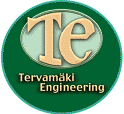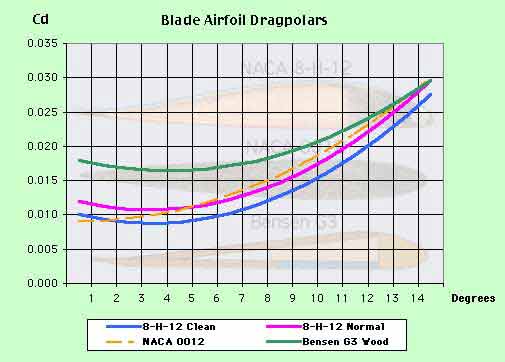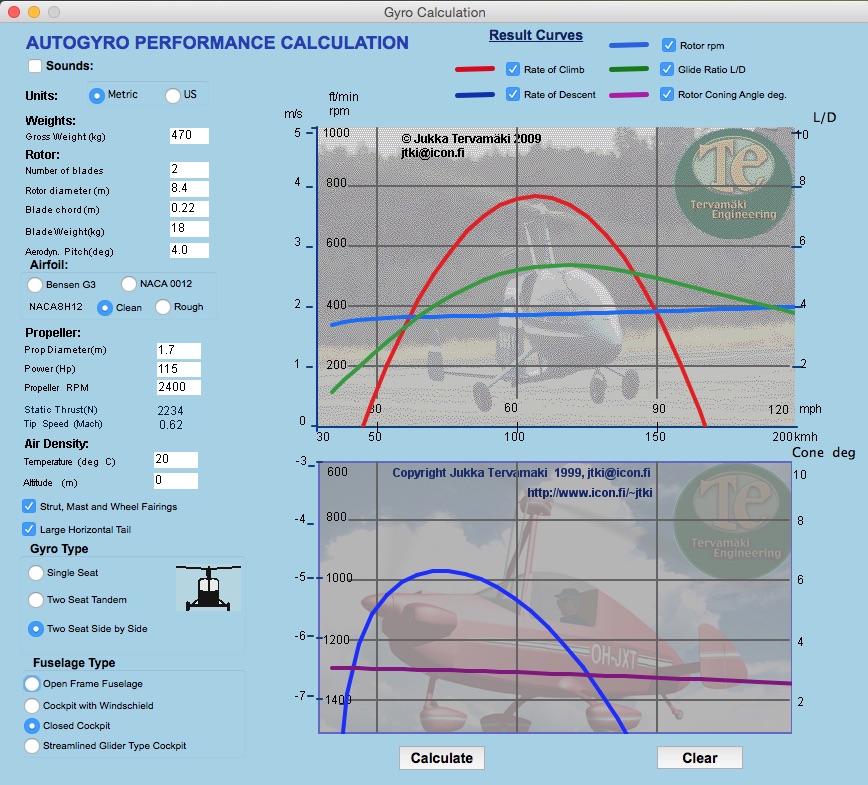| Composite Propeller | Safety | Hobbies| Site Map
|
Jukka Tervamaki, August 26, 2015 |

|
Here are the steps to utilize the program:
1) Download the program into your computer. Choose the right version for your computer type!
2) Unstuff (Mac) or Unzip (Windows) the program file and place it into the destination folder.
3) Carefully read the instructions below!
4) Input all the necessary dimensions and weights of your gyro design
into the appropriate editfields and activate the radio buttons and
checkboxes as necessary.
5) Press the Calculate button and you will have your gyro performance
in a neat diagram. The upper part of the diagram shows autogyro
climb rate, rotor rpm and glide ratio L/D. The lower part shows
power off descent and rotor coning angle.
Program Basis:
The program is a simplified version of my work at the Helsinki
University of Technology in 1959-1962, which in turn was largely based
on the book Aerodynamics of the Helicopter by Gessow and Myers. The
book contains calculation data from the NACA Report 716 by F.J. Bailey
Jr. Airfoil data is based on the NACA TN 1998 in addition to some other
NACA papers.
This is not the first time I have written
my autogyro equations into computer language. The GyroCalc was written
already in 1968 for the room-size Elliot 803 computer using Fortran
language. You can see the early computer readout in the July-August-1969 issue of the Popular Rotorcraft Flying magazine on page 23!
The data fields in the GyroCalc are pre-filled with example data from my JT-5 autogyro. To evaluate the performance of your own design, just type in new values, get the parametric data from my server and press the Calculate button. The program is freeware, and two versions are available for downloading:
Downloads: Newest files were compiled in August 2015! The reason was the new gyro drag data which I obtained by using a virtual wind tunnel. Take a look at my FEA & CFD page.
GyroCalc.zip, 2 Mb for Intel Macs (Download and unzip the file)
GyroCalcWin.zip, 1,6 Mb for Windows machines later than 2000.
INPUT OPTIONS:.
Units: choose either metric or US units to type in your data on the white editfields. Note the units in parentheses. Use decimal values for US units as well, e.g. decimal feet.
Weights: input the estimated gross weight.
Rotor:
The number of blades, rotor diameter and the blade chord are self
explanatory. The blade weight is needed for the flapping angle
calculations. The program assumes a blade weight distribution similar
to JT-5 composite blades. Other blades may have different weight
distributions causing a small error in the flapping angle values.
Aerodynamic pitch differs from geometric pitch for asymmetric airfoils
such as the NACA 8-H-12. Be sure to use the correct value, otherwise
the computation results are completely erroneous. A four degrees
aerodynamic pitch is usually considered the optimum. Lower values
result in a higher rpm but poor efficiency and high values may result
in blade stall (which is not included in the computation).


Airfoil:
the NACA Rep. 716 calculation method simulates rotor blade profile drag
characteristics by 2nd power equations. The above picture shows
simulated drag curves for airfoils commonly used in experimental
rotorcraft.
The NACA 8-H-12 is a kind of laminar flow
airfoil with a low drag bucket. However, small autogyro rotor blades
operate at relatively low Raynolds numbers and it is difficult to build
the blades with high enough accuracy and surface quality to achieve
these low drag values. Therefore, the simulated curves are on the
realistic side.
The Bensen G3 drag curve is close to the actual measured wind tunnel data I obtained from Dr. Bensen in 1959.
Air Density: Gyros are very sensitive to air density, and the performance deteriorates rapidly with increasing altitude and air temperature. If your airfield is high in the mountains in a hot place, type in the values as necessary.
Gyro Type: These radio buttons adjust the frontal area of the gyro for drag calculations.
Fuselage Type: These radiobuttons adjust the drag coefficient of the fuselage for power required calculations. Be honest, if your gyro is "boxy" or aerodynamically dirty (a lot of unfaired protrusions), jump one step upwards even if your gyro has a fully enclosed cockpit.
Large Horizontal Tail: All gyros have a vertical tail but only some of them have a horizontal one. A large horizontal tail adds stability and safety against PIO but it also adds some weight and drag. This checkbox adjusts the drag for a large horizontal tail (similar to the one in the JT-5).
Strut, Mast and Wheel Fairings: Very few gyros have complete fairings for every detail. The CarterCopter is one of the very few exceptions. If you intend to use extensive fairings, this checkbox will simulate the resulting drag drop.

Resuts: Press the Calculate button and the program calculates the performance of your gyro in a split second. You can change your input data at will and recalculate new performance curves making comparisons of different choices. If the graphics window gets congested, press the Clear button.
What you can see from the curves is that maximum climb and minimum sink do not coincide. This is mainly due to the fact that propeller propulsive efficiency is increasing with speed.
Validity of the Results:
results should be valid for one or two seat gyros. Extremes like small
model gyros or the big CarterCopter are out of range for this program.
If nothing else, you can use the program for comparative calculation between various configurations or just as a "game".
Notice! Arial font has been specified for the program. If you don't have this font, your system will substitute another font which might not fit all spaces provided.
GyroCalc was written and compiled using RealBasic 5.1 (http://www.realsoftware.com/realbasic/) in an Intel iMac computer.
COMMENTS:
Thank you to everyone who has sent a comment. As of September 2000 I have received several comments but none giving exact information for a possible parameter adjustment. Anyway, I am happy that some gyro enthusiasts have found this software useful.
1) I like your program, it'll be very useful when the engine goes on my Bensen and I run the numbers for it. ;-')
Regards, Philip.
2)
I have downloaded and run your performance software. It looks to be
giving realistic figures. As soon as I get a chance I will compare them
with my machine. The rotor coning angle is higher than I expected so I
will video the machine and catch a frame with the blades at the right
angle and measure the cone angle.
Again thanks for making this work available and I look forward to matching my machine to it.
Regards, Graeme
3)
Congratulations Jukka for presenting the new "Gyro Calculations". I
have downloaded the program and will enjoy seeing if it can be applied
in any way possible to our Radio Controlled model versions. Your skills
and knowledge is notable... I thank you.
Jim Baxter
4)
I love your website. The Gyro Performance Calc program is great. I
especially like the JT-9. Beautiful machine concept. Thanks,
Jeff
5)
I just wanted to pass on to you how impressed I was with your auto gyro
engineering. I am an electrical engineer, working at BFGoodrich, where
we work on helicopter systems. However, I find that for personal use, I
would much rather have an autogyro (less complex, faster, and I really
don't need to hover). At any rate, of all the information I have seen
on the internet - your site is the best regarding autogyros.
Sincerely, Eric Bechhoefer
6)
I have recently discovered your website on autogyros, I was impressed
with your work and also the program for performance calculations of
gyros. I am a 4th year student at Bristol University, England and I am
currenly researching jump-take off and towering climb on
autogyros............................
Colin Swain.
7) I have been through your site and very much am impressed with your work and your gyro calculator!
Ken Matherne
8)
I recently encountered your web page and love the GyroCalc program. I
also like your gyroplane designs you have worked on. You must have
spent many hours modeling every detail on your CAD system.
Troy Schank
| Composite Propeller | Safety | Hobbies| Site Map